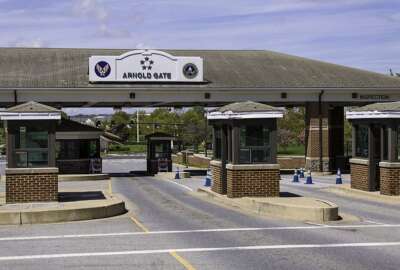
Army installations commander says time to scrap 2005 concept that created joint bases
The commander of the Army's Installation Management Command says joint basing has eroded warfighting readiness, and failed to save any money.
Best listening experience is on Chrome, Firefox or Safari. Subscribe to Federal Drive’s daily audio interviews on Apple Podcasts or PodcastOne.
More than a decade after the Pentagon began to consolidate the management of 26 military installations into newly-dubbed “joint bases,” one of the Army’s top installations officials said it is clear that the idea has failed to produce the cost savings promised and that it is time to scrap the idea altogether.
The Defense Department formally proposed joint basing in 2005 as part of the latest round of base realignments and closures (BRAC). Pentagon officials projected at the time that consolidating the management and support functions of installations that were physically located near one another would save $2.3 billion over 20 years.
By 2013, DoD had lowered that estimate to $830 million. But according to the Government Accountability Office, the department has never delivered convincing evidence that the joint basing strategy could achieve even that smaller figure.
Lt. Gen. Kenneth Dahl, the commanding general of Army Installation Management Command (IMCOM), said he has seen no proof of dollar savings either, and that the idea of joint basing plainly has not worked.
“I don’t buy the data that says we’re saving money, and I don’t know any senior commanders or other people who like it,” Dahl said at the Association of the U.S. Army’s annual “hot topic” conference on installation management. “[IMCOM] may be spending less money, but the mission units are probably spending more to do what they need to do, so I’m not sure we’re capturing the total costs, and our readiness may be suffering.”
Looking to save costs
The 2005 BRAC process consolidated what had been 26 separate bases into 12 for administrative purposes without changing their previous physical boundaries or missions. The names of the bases were converted into combined monikers like Joint Base Elmendorf-Richardson, Joint Base Langley-Eustis, and Joint Base Lewis-McChord.
But GAO said any cost savings that have been achieved through that process have been because of actions taken at the discretion of individual joint base commanders, and many of those commanders have struggled to converge certain support services into shared ones. That is especially true when those services have distinct features or requirements that are unique to the Army, Navy, Air Force or Marine Corps. Some examples include military personnel services, information technology and legal advisory services.
Dahl said savings can be achieved by changing the military’s management and oversight of its bases, but that they’re to be found much higher in DoD’s organizational chart.
Rather than targeting certain installations for localized savings, he said DoD should create a new joint agency to combine all of the planning, budgeting and management functions the military services currently perform independently within their headquarters.
“Somebody’s got to man this thing, so it’s a matter of taking the best things from all of the services, running them up to the Department of Defense level, and eliminating the service proponencies for all of this inside the Pentagon,” he said. “The money to be saved is in the Pentagon and at the high level of enterprising, not picking 10 or 12 places and trying to find savings at the subordinate level.”
Dahl argued that apart from failing to save money, joint basing has had negative cultural implications for each of the military services that have been impacted by the restructuring of base management.
“There’s a human dimension to this. There’s a reason the Air Force has a different culture from the Army,” he said. “And when you try to run a joint base, you actually erode that culture, which is critical to their combat effectiveness.”
Doing so, he said, could also let DoD eliminate unnecessary inefficiencies in how some military installations are managed.
As an example, Dahl offered the Blossom Point field testing range in Southern Maryland. It is owned and managed by the Army, but at the moment, no Army missions are performed there; its only current tenants are various Navy organizations. He said IMCOM runs the testing range on a reimbursable basis, which means talent can only be hired on a temporary or term basis.
“The problem with that is when it’s purely reimbursable, you never know when they’re just going to say, ‘We don’t need anything next year,'” he said. “A Department of Defense enterprise could say, ‘Ok, what’s the requirement for DoD at Blossom Point? Let’s make it permanent, let’s program for it, let’s hire the talent that we need and build readiness. I just think that’s a better model.”
A boost in the budget
In related installations news, the omnibus appropriations bill passed by Congress and signed by the president last week delivered some good news to the Army. Each of the military services faced billions of dollars in backlogged military base maintenance, and the Army has previously said that nearly a quarter of its facilities are in poor or failing condition.
The legislation delivers $3.5 billion in facilities sustainment, restoration and modernization funding to the Army for the remainder of 2018 — more than $1 billion above what Congress provided in 2017 and almost $200 million more than the Army asked for in 2018.
Copyright © 2025 Federal News Network. All rights reserved. This website is not intended for users located within the European Economic Area.
Jared Serbu is deputy editor of Federal News Network and reports on the Defense Department’s contracting, legislative, workforce and IT issues.
Follow @jserbuWFED
Related Stories






